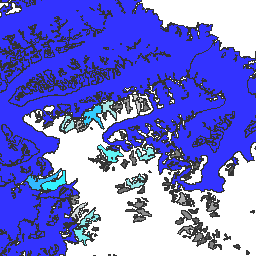
- Disponibilidad del conjunto de datos
- 1750-01-01T00:00:00Z–2023-06-07T00:00:00Z
- Proveedor de conjuntos de datos
- National Snow and Ice Data Center (NSDIC)
- Etiquetas
Descripción
Global Land Ice Measurements from Space (GLIMS) es una iniciativa internacional cuyo objetivo es realizar estudios repetidos de los aproximadamente 200,000 glaciares del mundo.
El proyecto busca crear un inventario integral a nivel mundial del hielo terrestre, incluidas las mediciones del área, la geometría, la velocidad de la superficie y la elevación de la línea de nieve de los glaciares. Para realizar estos análisis, el proyecto GLIMS utiliza datos satelitales, principalmente del Radiómetro Avanzado de Emisión y Reflexión Térmica Aerotransportado (ASTER) y el Explorador Temático Mejorado Plus (ETM+) de Landsat, así como información histórica derivada de mapas y fotografías aéreas.
Cada elemento de este conjunto de datos es un límite poligonal de un glaciar en el momento del análisis. Algunos IDs de glaciares tienen cientos de filas distintas a lo largo del tiempo.
Este conjunto de datos es una instantánea del inventario de los límites de los glaciares al 7 de junio de 2023, y proporciona más de 1,100,000 filas.
Esquema de la tabla
Esquema de la tabla
| Nombre | Tipo | Descripción |
|---|---|---|
| analistas | STRING | Nombres de los colaboradores de datos |
| anlys_id | DOUBLE | ID de un glaciar en un momento determinado |
| anlys_time | STRING | Cuándo se realizó el análisis |
| área | DOUBLE | Área del glaciar en el plano de la proyección del mapa en kilómetros cuadrados |
| chief_affl | STRING | Afiliación del jefe del centro regional |
| db_area | DOUBLE | Es igual que "area", pero se vuelve a calcular con el proyecto de GLIMS. |
| geog_area | STRING | Nombre de la región geográfica que abarca el centro regional |
| glac_id | STRING | ID de glaciar de GLIMS |
| glac_name | STRING | Es el nombre del glaciar. Alrededor del 80% de las filas son iguales a "None". |
| glac_stat | STRING | Estado de Glacier, que puede ser "exists" o "None" |
| longitud | DOUBLE | Longitud del perímetro del glaciar en metros |
| line_type | STRING | Tipo de registro de glaciar, p.ej., "glac_bound" para glaciares, o bien otros valores para rocas internas, líneas de nieve, accidentes geográficos acuáticos, etc. |
| local_id | STRING | ID asignado por la institución colaboradora o el centro regional |
| max_elev | DOUBLE | Parte más alta del glaciar, en metros sobre el nivel del mar |
| mean_elev | DOUBLE | Elevación media del glaciar, en metros sobre el nivel del mar |
| min_elev | DOUBLE | Parte más baja del glaciar, en metros sobre el nivel del mar |
| ID del padre | STRING | ID del glaciar principal de este glaciar |
| primeclass | DOUBLE | Número de clasificación de glaciares del WGMS |
| proc_desc | STRING | Descripción del tratamiento de datos que se realiza en este registro |
| rc_id | DOUBLE | ID que usa el centro regional |
| rec_status | STRING | Estado de registro |
| release_dt | STRING | Fecha en que se publicaron los datos, en formato aaaa-MM-ddTHH:mm:ss |
| src_date | STRING | Fecha de las imágenes de origen que se usaron para crear el esquema |
| subm_id | DOUBLE | ID de envío asignado por GLIMS |
| Remitentes | STRING | Nombre(s) de quien envía los datos |
| wgms_id | STRING | ID del Servicio Mundial de Supervisión de Glaciares |
| ancho | DOUBLE | Ancho del glaciar en metros |
Condiciones de Uso
Condiciones de Uso
Para la creación de informes, publicaciones, conjuntos de datos nuevos, productos derivados o servicios que resulten del conjunto de datos, los usuarios deben citar: GLIMS y NSIDC (2005, actualizado en 2013): Base de datos de glaciares de mediciones globales de hielo terrestre desde el espacio. Compilado y puesto a disposición por la comunidad internacional de GLIMS y el Centro Nacional de Datos sobre Nieve y Hielo, Boulder, CO, EE.UU., doi:10.7265/N5V98602
DOI
Explora con Earth Engine
Editor de código (JavaScript)
var dataset = ee.FeatureCollection('GLIMS/current'); var visParams = { palette: ['gray', 'cyan', 'blue'], min: 0.0, max: 10.0, opacity: 0.8, }; var image = ee.Image().float().paint(dataset, 'area'); Map.setCenter(-35.618, 66.743, 7); Map.addLayer(image, visParams, 'GLIMS/current'); Map.addLayer(dataset, null, 'for Inspector', false);
Visualiza como FeatureView
Un FeatureView es una representación acelerada y de solo lectura de un FeatureCollection. Para obtener más detalles, consulta la
documentación de FeatureView.
Editor de código (JavaScript)
var fvLayer = ui.Map.FeatureViewLayer('GLIMS/current_FeatureView'); var visParams = { color: { property: 'area', mode: 'linear', palette: ['gray', 'cyan', 'blue'], min: 0.0, max: 10.0 }, opacity: 0.8, polygonStrokeOpacity: 0 }; fvLayer.setVisParams(visParams); fvLayer.setName('GLIMS/current'); Map.setCenter(-35.618, 66.743, 7); Map.add(fvLayer);
